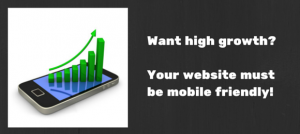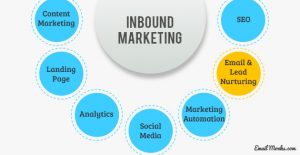The Current State of Email Marketing
Email remains one of the most used and effective marketing channels. When done properly, email has the potential to leverage sales, generate new customers and boost retention.
Recent research by Demand Metric and Return Path examine the current state of email marketing today, including brands’ top objectives, challenges and successes.
Some of the key findings from this years’ (2019) report include:
- The top email marketing objectives are communicating with customers (74 percent), building brand awareness (64 percent), and communicating with prospects (63 percent).
- Over one-third of study participants (37 percent) report that email marketing effectiveness is increasing, down from 44 percent in 2018.
- Firms that report increasing email marketing effectiveness are more likely to also report annual revenue growth.
- The biggest email marketing challenge is competition for attention in the inbox (45 percent).
- Email deliverability ranked third on the list of challenges and saw a 12 percent increase compared to the 2018 study.
- Email personalization was the top email marketing tactic in use (72 percent), a slight increase from the 2018 study.
- One-third of study participants have no formal subject-line optimization process.
Email Marketing Challenges
Competing for attention remains the number one challenge for email marketers at 45%. However, other top challenges included:
- Staffing/resource constraints (40%)
- Email deliverability (37%)
- Lack of tools to personalize or optimize email (31%)
- Poor email performance (24%)
Email Marketing Tactics & Tools
In an effort to try and improve email effectiveness, some of the top tactics email marketers employed included:
- Email personalization (72%)
- Email list management (63%)
- Subject line optimization (52%)
- Email deliverability optimization (51%)
- A/B testing (50%)
When compared to last year, the big changes come in greater adoption of email deliverability optimization and A/B testing.

Email marketers who are seeing higher average open rates are getting them because of these tactics.

In another recent study by Econsultancy and Upland Adestra, email marketers stated they would like to improve their email personalization tactics, cross-channel data insights and segmentation techniques to name a few.
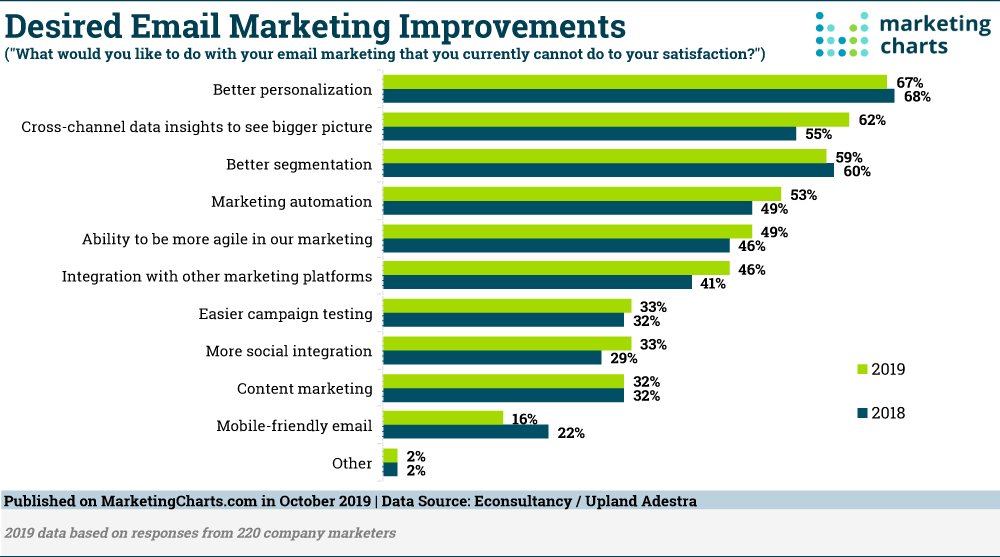
As far as challenging to implementing better email personalization. The survey revealed that 51% of marketers said data integration is the biggest obstacle to personalization.
Utilizing better device optimization strategies is an area that still needs improvement. Only 40% of companies describe their strategy for optimizing email on different devices as basic, with a further 10% describing it as non-existent. Twenty four percent of respondents say that ‘a lack of time to make it happen’ is the main barrier to success when it comes to effectively optimizing email campaigns for different devices.
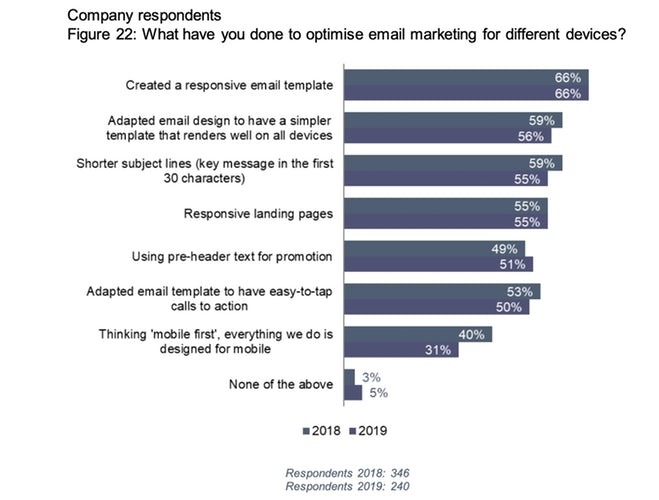
Tactics You Should Be Employing Today
Email Segmentation:
You are probably employing some type of email segmentation based on your subscriber list. Perhaps you have lists segmented by behavior, interests or demographics. However, take a fresh look at your techniques and see if there are additional methods you can utilize. As data gets more sophisticated, your lists can be analyzed by more data points to create smaller segments and better personalized emails.
The effort is well worth it. Segmented emails simply perform better:
- Marketers found a 760% increase in email revenue from segmented campaigns (DMA).
- Segmented email campaigns have an open rate that is 14.32% higher than non-segmented campaigns. (Mailchimp)
- Segmented email campaigns based on database fields get 54.79% higher clicks than non-segmented campaigns (Mailchimp)
There are any numbers of ways your email lists can be segmented. Start by looking at some of the basic criteria and combine different elements to create segmentation models.
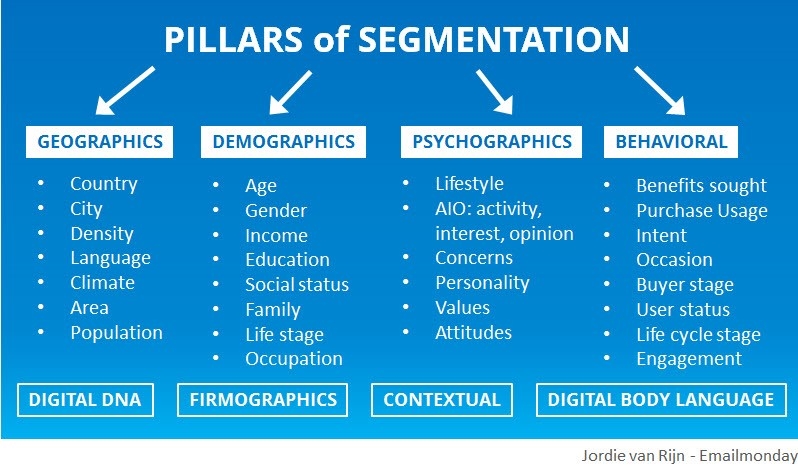
Automated Email Journeys:
Triggered emails are a key component in communicating relevant messages at the right time with your customer-base. Sending triggered emails based on a consumer’s behavior is effective for both acquisition and transforming customers into loyal brand advocates.
Check out these stats on the effectiveness of email marketing automation:
- Automated emails get 119% higher click rates than broadcast emails. (Epsilon)
- B2C marketers who connect with customers through automated emails see conversion rates as high as 50%. (eMarketer)
- Relevant emails drive 18x more revenue than broadcast emails. (Jupiter Research)
- Retailers who send a series of welcome emails see 13% more revenue than those who send just one. (Internet Retailer 500)
- Birthday emails can lift conversion rates by 60% over non-birthday emails with the same offer. (ClickZ)
While many brands are very familiar with welcome emails or order confirmations, email automation must be holistically integrated throughout the journey to increase conversions and boost retention.
Consider these examples of customer journeys to engage with consumers at different points across the customer journey:
Engagement/Brand Awareness
Welcome, Birthday, Re-Engagement, Engaged Non-Buyers, Profile Updates
Cross-sell/Upsell
Abandoned Cart, Abandoned Browser, Next Best Offer, First Order
Acquisition
Purchase Intenders, Competition Conquests, Top Tier Look-alikes, Life Events
Nurture/Purchase Oriented
Nurture, Renewal Reminder, Loyalty, VIP, Thanks for Purchase
Optimize for Mobile
First and foremost, if you aren’t designing your emails for mobile devices, chances are that your message is not getting the attention it deserves. Mobile-friendly design is the most crucial component for successful mobile email marketing. In fact, 80% of users will delete an email if it does not look good on their mobile devices, according to Blue Hornet.
According to research by MailChimp, responsive email design, which adapts to different devices and screen sizes, gets higher click rates on all devices. They are particularly effective for mobile users, where the increase in unique clicks from 2.7% to 3.1% represents a 15% increase in actual clicks.
Include a Clear Call To Action (CTA)
Did you know that emails with a single call-to-action increase clicks 371% and sales $ 1,617? (WordStream). And when you take the time to optimize them, your click-through rates can soar. Check out these stats about the benefits of optimizing CTAs:
- HubSpot found that anchor text CTAs increased conversion rates by 121%. Between 47% and 93% of a post’s leads ONLY come from anchor text CTAs. 83% to 93% of each post’s leads come from anchor text AND internal link CTAs.
- ContentVerve saw a 90% increase in click-through rate by using first-person phrasing: “Start my free 30 day trial” vs. “Start your free 30 day trial.”
- Helzberg Diamonds saw a 26% increase in clicks by adding an arrow icon to their CTA buttons. (Marketing Tech Blog)
- SAP found that orange CTAs boosted their conversion rate over 32.5%. (QuickSprout)
- Performable found that red CTAs boosted their conversion rate by 21%. (QuickSprout)
- Making CTAs look like buttons created a 45% boost in clicks for CreateDebate. (Copyblogger)
- Personalized CTAs convert 42% more visitors into leads than untargeted CTAs. (HubSpot)
- Neil Patel found that users prefer to learn about the offer before clicking a CTA– placing his CTA above the fold decreased conversions by 17%. (QuickSprout)
- Reducing clutter around their CTA increased Open Mile’s conversion rate by 232%. (VWO)
- FriendBuy increased signups by 34% by adding anxiety-reducing content and explaining key benefits next to their CTA. (Copyblogger)
Remember that perfecting your CTA’s will take time. It’s best to include only one clear call to action per email and in some instances a secondary, lower urgency, CTA in case the subscriber is not ready to engage with the main CTA. Keeping emails short, sweet, and to the point will help prevent your subscribers becoming distracted or overwhelmed.
As for call to action placement, the best position will vary based on your content. Traditional opinion is that it’s best to place your CTA above the fold to reduce the need for scrolling, but as seen in the QuickSprout statistic above, some users need more of an explanation about the offer before following through. An offer for “10% off of your next order” is self-explanatory and would benefit from being above the fold, but “fill out this form” may need some more details to support it. In the end, taking the time to test your CTA’s to see what produces the best results in your email campaigns is the only truly effective way to optimize your campaigns.
Email is a highly effective tool and the foundation of today’s omnichannel marketing strategies. While this makes email more challenging to stand out in a crowded marketplace, using tried and true techniques to make your emails stand out will go a long way in driving conversions, loyalty and strong revenue.
Interested in what you are reading? Learn about additional marketing tactics and strategies – download our free ebook on omnichannel marketing tactics.
Digital & Social Articles on Business 2 Community
(55)


